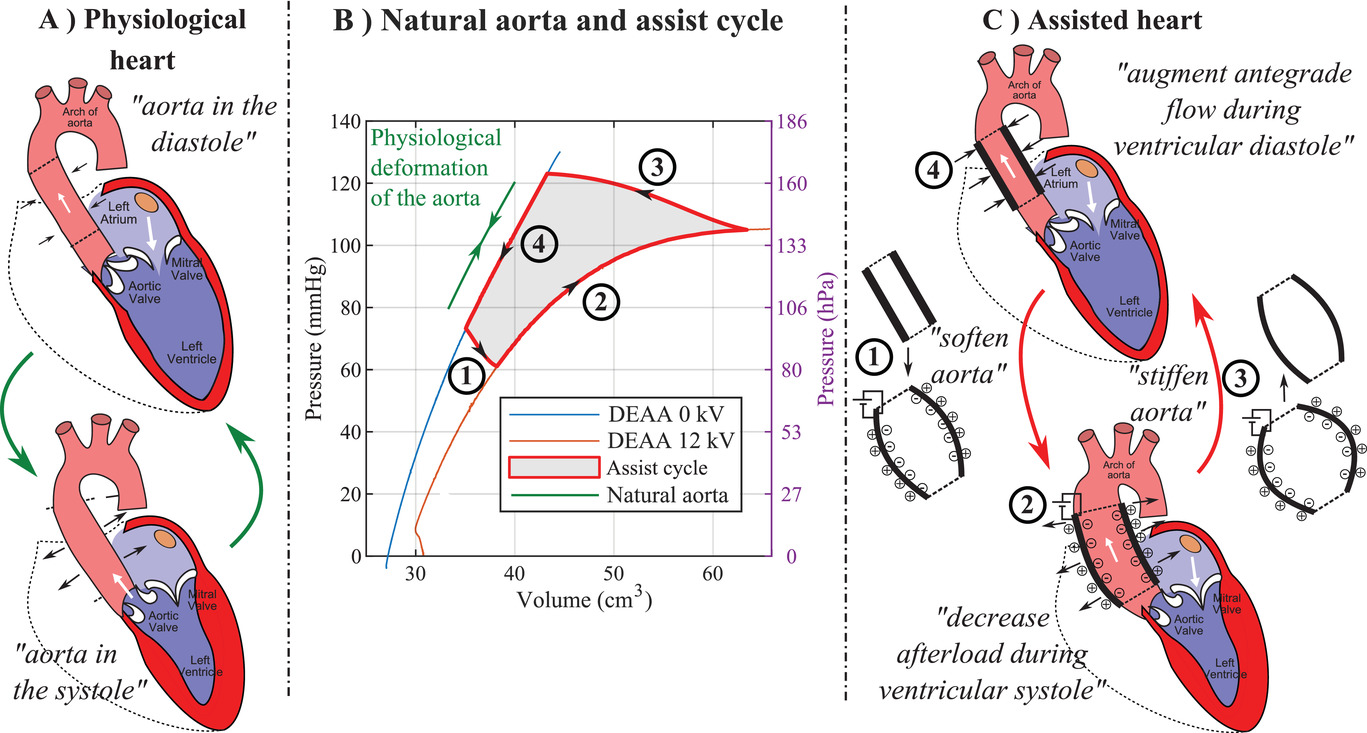2021/02/03 | Research | In-vitro & Organs-on-Chip
Dielectric Elastomer Actuator to Assist Failing Hearts
The Integrated Actuators Laboratory, École Polytechnique fédérale de Lausanne (EPFL) in collaboration with the ARTORG Cardiovascular Engineering group has developed and tested a dielectric‐elastomer actuator (DEA) for the aorta that can assist patients with heart failure and offer a potential alternative to heart transplantation. In vitro experiments using a pulsatile flow‐loop showed the DEA reduced the energy that the heart has to exert by 5 percent and is driven by the physiological pressure of the aorta itself.
 Working principle of a dielectric‐elastomer‐augmented aorta (DEAA) for cardiac assist device. A) Physiological behaviour of the heart highlighting the diastolic and systolic phases. B) Pressure–volume characteristic of a biological aorta and of an DEAA. C) DEAA working principle: 1) at end of the diastole, the voltage is applied and the DEA expands; 2) during the systole, the pressure increases leading to an expansion of the DEA; 3) at end of the systole, the voltage is removed and the DEA contracts; 4) during the diastole, the pressure decreases leading to a contraction of the DEA.
(Morgan Almanza et al. Feasibility of a Dielectric Elastomer Augmented Aorta, Advanced Science https://doi.org/10.1002/advs.202001974)
Working principle of a dielectric‐elastomer‐augmented aorta (DEAA) for cardiac assist device. A) Physiological behaviour of the heart highlighting the diastolic and systolic phases. B) Pressure–volume characteristic of a biological aorta and of an DEAA. C) DEAA working principle: 1) at end of the diastole, the voltage is applied and the DEA expands; 2) during the systole, the pressure increases leading to an expansion of the DEA; 3) at end of the systole, the voltage is removed and the DEA contracts; 4) during the diastole, the pressure decreases leading to a contraction of the DEA.
(Morgan Almanza et al. Feasibility of a Dielectric Elastomer Augmented Aorta, Advanced Science https://doi.org/10.1002/advs.202001974)
In the study a team of engineers and clinicians presented the first dielectric‐elastomer‐augmented aorta (DEAA), consisting of a tubular DEA with an electrically driven compliance. It is designed to assist the pulsatile nature of the heart by means of an innovative aortic counter‐pulsation approach. The possibility of an electrically driven counterpulsation device paves the way for a fully implanted device (not possible for current pneumatically driven aortic counterpulsation devices) and for a high‐level cardiac assistance.
“The advantage of our system is that it reduces the pressure on a patient’s heart. The idea isn’t to replace the heart, but to assist it,” says Yoan Civet, a Scientist at the EPFL’s Integrated Actuators Laboratory. The study was supported by the Werner-Siemens Stiftung.
Link to the study
Media release EPFL, 3 February 2021
Further information on the project
Cardiovascular Engineering, ARTORG Center